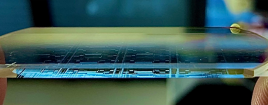Expanding the glass photonics technology towards the visible
Published : 14 October 2025

Expanding the glass photonics technology towards the visible
Location: CROMA Lab (UMR 5130), Grenoble, France 
Supervisors: Lionel BASTARD and Elise GHIBAUDO
Period and length: Spring 2026, 6 months.
Context:
The growing demand on environmental sensing leads the current development of compact, fast and portable sensors. Integrated photonics has the assets to meet
this demand thanks to its sensitivity and accessibility for real time monitoring.
Among the existing photonics technologies, glass-based ones have the advantage to provide a robust and relatively low-cost platform compatible with harsh or humid environment. CROMA has a long experience in developing ion-exchange on glass processes and in designing passive and active photonic functions such as
multiplexers, amplifiers or laser sources.
CROMA’s technology is now mature in the telecom bandwidth, located in the near infrared region. But to address environmental applications, we need now to open up our technology and develop processes on commercial glasses working in the visible spectrum and/or below the wavelength of 0.8 µm. Indeed, a lot of pollutants or greenhouse gases present absorption lines in this spectral range. The optical detection of microparticles by Mie diffusion is also enhanced in this bandwidth.
Internship objectives:
With this internship, we aim at developing a disruptive ion-exchange process on a commercial glass to provide CROMA with a novel photonics platform adapted to environmental sensing applications. The candidate will be in charge of different scientific steps involved in this development, including:
- the characterization and simulation of a new ion-exchange.
- the design and fabrication of photonic waveguides.
- the optical characterization of those waveguides’ performances.
Depending on the project progress and the candidate motivations, the orientation given to the internship final leg of the work may vary: design and test of bent
waveguides, co-integration of a microfluidic and an electric function to detect plastic microbeads in water…
Work and collaborative environment:
The candidate will be part of the PHOTO group and will work in close contact with PhD students. He/she will be trained and have access to the clean-room and
characterization equipment required for this project (fabrication of optical waveguides, measurement of waveguides index profile, guided modes and
propagation losses).
A PhD position may be discussed with the PHOTO group after the internship.
___________________________________________________________________________________________________________________________________
# integrated photonics
# glass technology
# environmental sensing
Desired profile & skills
2nd year Research Master or
3rd year Eng. School
– Microtechnology & fabrication
– Photonics
– Affinity & curiosity for experimental and numerical work
Send application to:
lionel.bastard@grenoble-inp.fr
elise.ghibaudo@grenoble-inp.fr
Additional information:
– CROMA lab
– integrated photonics sensor




 Contact us
Contact us How to find us
How to find us









